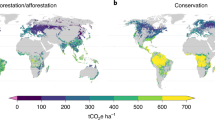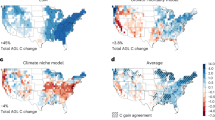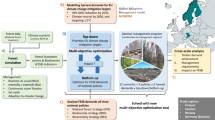Abstract
The Paris Agreement promotes forest management as a pathway towards halting climate warming through the reduction of carbon dioxide (CO2) emissions1. However, the climate benefits from carbon sequestration through forest management may be reinforced, counteracted or even offset by concurrent management-induced changes in surface albedo, land-surface roughness, emissions of biogenic volatile organic compounds, transpiration and sensible heat flux2,3,4. Consequently, forest management could offset CO2 emissions without halting global temperature rise. It therefore remains to be confirmed whether commonly proposed sustainable European forest-management portfolios would comply with the Paris Agreement—that is, whether they can reduce the growth rate of atmospheric CO2, reduce the radiative imbalance at the top of the atmosphere, and neither increase the near-surface air temperature nor decrease precipitation by the end of the twenty-first century. Here we show that the portfolio made up of management systems that locally maximize the carbon sink through carbon sequestration, wood use and product and energy substitution reduces the growth rate of atmospheric CO2, but does not meet any of the other criteria. The portfolios that maximize the carbon sink or forest albedo pass only one—different in each case—criterion. Managing the European forests with the objective of reducing near-surface air temperature, on the other hand, will also reduce the atmospheric CO2 growth rate, thus meeting two of the four criteria. Trade-off are thus unavoidable when using European forests to meet climate objectives. Furthermore, our results demonstrate that if present-day forest cover is sustained, the additional climate benefits achieved through forest management would be modest and local, rather than global. On the basis of these findings, we argue that Europe should not rely on forest management to mitigate climate change. The modest climate effects from changes in forest management imply, however, that if adaptation to future climate were to require large-scale changes in species composition and silvicultural systems over Europe5,6, the forests could be adapted to climate change with neither positive nor negative climate effects.
This is a preview of subscription content, access via your institution
Access options
Access Nature and 54 other Nature Portfolio journals
Get Nature+, our best-value online-access subscription
$29.99 / 30 days
cancel any time
Subscribe to this journal
Receive 51 print issues and online access
$199.00 per year
only $3.90 per issue
Buy this article
- Purchase on Springer Link
- Instant access to full article PDF
Prices may be subject to local taxes which are calculated during checkout


Similar content being viewed by others
Data availability
Figures 1, 2, Table 1, Extended Data Figs. 2, 3, Supplementary Fig. 1 and Extended Data Table 1, 2 are based on a simulation experiment whose output files (about 7.4 Tb) will be provided upon reasonable request. The data files that were used to set the boundary conditions of ORCHIDEE-CAN and LMDzORCAN (about 70 Gb) will be provided upon reasonable request.
Change history
05 March 2019
In this Letter, in “About 75% of this reduction is expected to come from emission reductions and the remaining 25% from land use, land-use change and forestry”, ‘25%’ should read ‘1%’ and '75%' should read '99%'. In the sentence “The carbon-sink-maximizing portfolio has a small negative effect on annual precipitation (−2 mm) and no effect on air temperature (Table 1)” the word ‘precipitation’ was omitted. Denmark was accidentally deleted during the conversion of Fig. 1. The original Letter has been corrected online.
References
Paris Agreement, FCCC/CP/2015/10/Add.1 https://unfccc.int/files/meetings/paris_nov_2015/application/pdf/paris_agreement_english_.pdf (United Nations Framework Convention on Climate Change, 2015).
Pielke, R. A. et al. Land use/land cover changes and climate: modeling analysis and observational evidence. WIREs Clim. Change 2, 828–850 (2011).
Naudts, K. et al. Europe’s forest management did not mitigate climate warming. Science 351, 597–600 (2016).
Jackson, R. B. Trading water for carbon with biological carbon sequestration. Science 310, 1944–1947 (2005).
Lindner, M. et al. Climate change impacts, adaptive capacity, and vulnerability of European forest ecosystems. For. Ecol. Manage. 259, 698–709 (2010).
Hanewinkel, M., Cullmann, D. A., Schelhaas, M.-J., Nabuurs, G.-J. & Zimmermann, N. E. Climate change may cause severe loss in the economic value of European forest land. Nat. Clim. Chang. 3, 203–207 (2013).
Grassi, G. et al. The key role of forests in meeting climate targets requires science for credible mitigation. Nat. Clim. Chang. 7, 220–226 (2017).
National Action Plans https://ec.europa.eu/energy/en/topics/renewable-energy/national-action-plans (European Commission, 2017).
Government Report on the National Energy and Climate Strategy for 2030 http://julkaisut.valtioneuvosto.fi/handle/10024/79247 (Finnish Ministry of Economic Affairs and Employment, 2017).
Décret N° 2017–155 du 8 Février 2017 Portant Approbation du Programme National de la Forêt et du Bois https://www.legifrance.gouv.fr/eli/decret/2017/2/8/AGRT1632600D/jo/texte (Legifrance, 2016).
Blennow, K., Persson, J., Tomé, M. & Hanewinkel, M. Climate change: believing and seeing implies adapting. PLoS One 7, e50182 (2012).
Kyoto Protocol to the United Nations Framework Convention on Climate Change https://unfccc.int/sites/default/files/kpeng.pdf (United Nations, 1998).
Erb, K.-H. et al. Land management: data availability and process understanding for global change studies. Glob. Change Biol. 23, 512–533 (2017).
Luyssaert, S. et al. Land management and land-cover change have impacts of similar magnitude on surface temperature. Nat. Clim. Chang. 4, 389–393 (2014).
Canadell, J. G. & Raupach, M. R. Managing forests for climate change mitigation. Science 320, 1456–1457 (2008).
Nabuurs, G. et al. A New Role for Forests and the Forest Sector in the EU Post-2020 Climate Targets https://www.efi.int/sites/default/files/files/publication-bank/2018/efi_fstp_2_2015.pdf (European Forest Institute, 2015).
Myhre, G., Highwood, E. J., Shine, K. P. & Stordal, F. New estimates of radiative forcing due to well mixed greenhouse gases. Geophys. Res. Lett. 25, 2715–2718 (1998).
Davin, E. L., Seneviratne, S. I., Ciais, P., Olioso, A. & Wang, T. Preferential cooling of hot extremes from cropland albedo management. Proc. Natl Acad. Sci. USA 111, 9757–9761 (2014).
Swann, A. L., Fung, I. Y., Levis, S., Bonan, G. B. & Doney, S. C. Changes in Arctic vegetation amplify high-latitude warming through the greenhouse effect. Proc. Natl Acad. Sci. USA 107, 1295–1300 (2010).
Lutz, D. A. & Howarth, R. B. Valuing albedo as an ecosystem service: Implications for forest management. Clim. Change 124, 53–63 (2014).
Arora, V. K. & Montenegro, A. Small temperature benefits provided by realistic afforestation efforts. Nat. Geosci. 4, 514–518 (2011).
Davin, E. L. & de Noblet-Ducoudré, N. Climatic impact of global-scale deforestation: radiative versus nonradiative processes. J. Clim. 23, 97–112 (2010).
Bathiany, S., Claussen, M., Brovkin, V., Raddatz, T. & Gayler, V. Combined biogeophysical and biogeochemical effects of large-scale forest cover changes in the MPI earth system model. Biogeosciences 7, 1383–1399 (2010).
Bala, G. et al. Combined climate and carbon-cycle effects of large-scale deforestation. Proc. Natl Acad. Sci. USA 104, 6550–6555 (2007); correction 104, 9911 (2007).
Beringer, J., Chapin, F. S., Thompson, C. C. & McGuire, A. D. Surface energy exchanges along a tundra-forest transition and feedbacks to climate. Agric. For. Meteorol. 131, 143–161 (2005).
Alkama, R. & Cescatti, A. Biophysical climate impacts of recent changes in global forest cover. Science 351, 600–604 (2016).
Unger, N. Human land-use-driven reduction of forest volatiles cools global climate. Nat. Clim. Chang. 4, 907–910 (2014).
Hurrell, J. W. Decadal trends in the North Atlantic oscillation: regional temperatures and precipitation. Science 269, 676–679 (1995).
Costanza, R. et al. The value of the world’s ecosystem services and natural capital. Nature 387, 253–260 (1997).
Seidl, R., Schelhaas, M.-J., Rammer, W. & Verkerk, P. J. Increasing forest disturbances in Europe and their impact on carbon storage. Nat. Clim. Chang. 4, 806–810 (2014); corrigendum 4, 930 (2014).
Acknowledgements
M.J.M., K.N., J.R., Y.-Y.C., J.O. and S.L. were funded through the European Research Council (ERC) starting grant 242564 and A.V. was funded through the Agence de l'Environnement et de la Maîtrise de l'Energie (ADEME). S.L. and G.M. were partly funded through an Amsterdam Academic Alliance (AAA) fellowship. S.L. is grateful for the mentorship of E.-D. Schulze, I. A. Janssens and P. Ciais. The ORCHIDEE and LMDZ project teams and the Centre de Calcul Recherche et Technologie (CCRT) provided the run environment that enabled the land–atmosphere simulations conducted in this study.
Reviewer information
Nature thanks T. Pugh and K. Zhao for their contribution to the peer review of this work.
Author information
Authors and Affiliations
Contributions
S.L. and M.J.M. designed the study. M.J.M., J.O., J.R., Y.-Y.C., K.N., A.V. and S.L. developed, parameterized and validated ORCHIDEE-CAN. G.M., M.J.M., J.G. and S.L. conducted the simulation experiment. S.N.D. developed the life-cycle analysis method. G.M., Y.-Y.C. and S.L. analysed the data. G.M., M.J.M., J.O., J.R., Y.-Y.C., K.N., A.V., A.S.L. and S.L. contributed to the interpretation of the results.
Corresponding author
Ethics declarations
Competing interests
The authors declare no competing interests.
Additional information
Publisher’s note: Springer Nature remains neutral with regard to jurisdictional claims in published maps and institutional affiliations.
Extended data figures and tables
Extended Data Fig. 1 Setup of the simulation experiments.
The experiments are described in the section ‘Simulation experiment’ in Supplementary Information. Simulations with ORCHIDEE-CAN are shown in black and simulations with LMDzORCAN are shown in red. Blue boxes denote intermediate calculations using the simulation results (see Supplementary Information, ‘Spatially optimized management portfolios’ and ‘Equilibrium climate for the management portfolios’). The simulations shown in this figure correspond to runs with reduced air temperature (BBESTT2M), maximized surface albedo (BESTALBEDO), minimized surface albedo (BWORSTALBEDO), maximized carbon sink (BBESTLCA), minimized carbon sink (BWORSTLCA) and business as usual (BWAC). BWAC, BWAC-P1 and BWAC-P2 were used to calculate the minimal model noise.
Extended Data Fig. 2 Drivers of the mean bimonthly air temperature changes for 0.5° latitudinal bands.
The notation is as in Fig. 2 and the labels at the top denote months (D J, December and January; F M, February and March; A M, April and May; and so on). Although all the components contribute to the change of the air temperature, changes in emissivity always result in cooling and changes in shortwave incoming radiation always result in warming. Consequently, emissivity and incoming shortwave radiation cannot explain the seasonal variation in air temperature changes. The other components are positively correlated with air temperature in some months and negatively correlated in others, which rules them out as the main driver of air temperature changes and suggests that the net effect is the outcome of the interplay between the different components.
Extended Data Fig. 3 Relationship between changes in springtime air temperature and changes in the fractional cover of deciduous forest for 0.5° latitudinal bands over Europe.
Locations where the tree species are maintained between 2010 and 2100 (that is, the difference Δ of the deciduous area is 0) could experience similar air temperature changes as neighbouring locations where one tree species is replaced by another, especially in Scandinavia, suggesting advection of heat and moisture. Nevertheless, at lower latitudes the spatial scale of this advection is limited to a few pixels (for example, Fig. 2a) corresponding to a range of 50–200 km. Furthermore, the temperature effect quickly saturates with the fractional cover change and shows a strong dependence on geographical location (see Supplementary Information). Whether this apparent geographical dependence is the outcome of climatic differences or of differences between northern and southern European deciduous species could not be established with the experimental setup used in this study.
Supplementary information
Supplementary Information
This file contains Supplementary Methods, a Supplementary Discussion, Supplementary Figure 1, Supplementary Tables 1-3 and Supplementary References
Supplementary Data
This file contains source data for Supplementary Figure 1
Rights and permissions
About this article
Cite this article
Luyssaert, S., Marie, G., Valade, A. et al. Trade-offs in using European forests to meet climate objectives. Nature 562, 259–262 (2018). https://doi.org/10.1038/s41586-018-0577-1
Received:
Accepted:
Published:
Issue Date:
DOI: https://doi.org/10.1038/s41586-018-0577-1
Keywords
This article is cited by
-
Quantifying the impact of key factors on the carbon mitigation potential of managed temperate forests
Carbon Balance and Management (2024)
-
European forest sinks and climate targets: past trends, main drivers, and future forecasts
European Journal of Forest Research (2023)
-
Joint optimization of land carbon uptake and albedo can help achieve moderate instantaneous and long-term cooling effects
Communications Earth & Environment (2023)
-
The role of wood harvest from sustainably managed forests in the carbon cycle
Annals of Forest Science (2022)
-
Deforestation intensifies daily temperature variability in the northern extratropics
Nature Communications (2022)
Comments
By submitting a comment you agree to abide by our Terms and Community Guidelines. If you find something abusive or that does not comply with our terms or guidelines please flag it as inappropriate.



